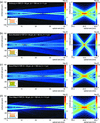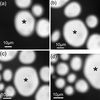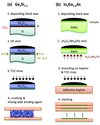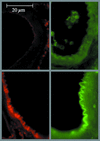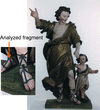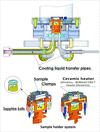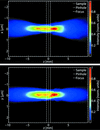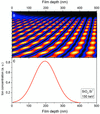issue contents
May 2013 issue

Cover illustration: Investigating the chemical composition and spatial distribution of the major components on the cicada Psaltoda claripennis wing surface. Top: optical profile of part of a cicada wing, including a wing vein. Bottom left: cicada Psaltoda claripennis perched on native flora. Bottom right: SEM image. The blue profile overlay shows a typical FTIR spectrum of a cicada wing membrane (see Tobin, Puskar, Hasan, Webb, Hirschmugl, Nasse, Gervinskas, Juodkazis, Watson, Watson, Crawford and Ivanova, pages 482-489).
facility information
research papers
Open  access
access
 access
accessAn efficient computing simulation routine has been implemented to model explicitly several types of Fresnel zone plate taking advantage of the circular symmetry. This code was used to evaluate an optimized approach for stacking of two high-resolution Fresnel zone plates.
For every analyzer-based imaging system there is a unique system configuration which allows the constituent materials of a sample to be distinguished to a desired statistical certainty for the minimal surface absorbed dose delivered to that object. This value is determined for a sample case and the variables involved are discussed.
Micro- and nano-bubbles were investigated by soft X-ray microscopy.
Open  access
access
 access
accessSoft X-ray photoabsorption spectroscopy under normal ambient-pressure conditions using electron yield detection was demonstrated. This technique provided unambiguous photoabsorption data for hydrated transition-metal compounds and identified the different chemical states of cobalt ions.
Lift-off protocols for thin films of semiconductor and dielectric materials are presented, allowing the structural properties of condensed matter to be studied with EXAFS with improved accuracy.
Open  access
access
 access
accessThe fabrication and performance of multilayer Al2O3/Ta2O5 Fresnel zone plates in the hard X-ray range and a discussion of possible future developments considering available materials are reported.
Synchrotron radiation is utilized to assess both pulmonary vessel density and endothelial function in a Dahl rat model of congestive heart failure with secondary pulmonary hypertension.
In order to study the properties of key B4C-based multilayers, X-ray grazing-incidence reflectivity and diffuse scattering were used to characterize multilayer structures synthetically, including information of the thickness, density, interfacial roughness, interdiffusion, surface state and correlation length.
The contrasting impurity effects of Mn and Zn dopants on the critical temperature of optimally doped Ba0.5K0.5Fe2As2 superconductors have been investigated by Fe and As K-edge X-ray absorption fine-structure spectroscopy.
Eighteenth-century preparative methods play a role in the fading of Prussian-blue-containing paint layers because they can lead to the production of nanocrystalline ferrihydrite mixed with Prussian blue.
A multipurpose portable vacuum-compatible chamber designed to carry out grazing-incidence X-ray scattering measurements is described. The main advantage of this chamber design is the wide sample temperature range, which may be varied between 60 and 1000 K, and the wide pressure range, which may be varied between 10−11 mbar and 3 bar.
The surface chemistry of the wings of the Clanger cicada Psaltoda claripennis has been studied using two synchrotron infrared beamlines. A heterogeneous surface distribution of long-chain hydrocarbons has been observed, which can account for this insect wing's previously observed heterogeneous superhydrophobicity, and which will assist in further understanding the structure and function of similar insect wings.
A ptychographic characterization of the KB focus in the dedicated nano-imaging setup GINIX at the P10 coherence beamline of the PETRA III synchrotron at HASLYLAB/DESY is reported. Different focal settings are realized via optical filtering and changing the size of the entrance aperture.
Time-resolved X-ray PIV technique for diagnosing opaque biofluid flow with insufficient X-ray fluxes
The temporal resolution of the X-ray particle image velocimetry technique is greatly improved by adopting an image intensifier at beamlines with insufficient X-ray fluxes. Proper digital image processing methods are found to be inevitably useful for improving the image quality and enhancing measurement accuracy.
A novel gas cell with a laser heating system has been designed to follow in situ reactions by X-ray absorption spectroscopy techniques under atmospheric pressure.
computer programs
The present work establishes a new numerical technique and corresponding software to model the phenomenon of incident synchrotron radiation interference in the photoluminescence excitation spectra of thin transparent films and to restore the shape of distorted spectra.
current events
Free 



 journal menu
journal menu

















